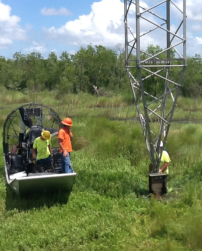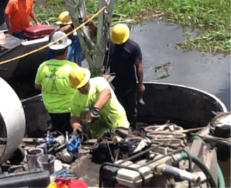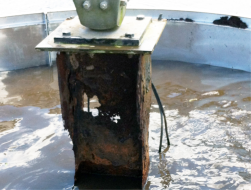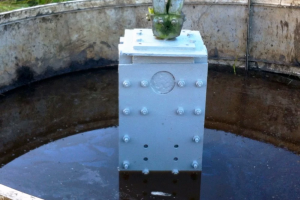Guyed Mast Tower Restoration
Implementing a practical and cost-effective life extension solution in a protected wetland
 The Situation
The Situation
Restorations were needed on 69 different foundations supporting 230 kV guyed mast towers running through a protected wetland. Osmose was able to assist, leveraging designs from our in-house structural engineering team, by executing a highly complex restoration solution with our experienced operations personnel.
A routine aerial inspection revealed corrosion on the tower foundations. The aerial inspection was followed by a detailed marine survey, which revealed the severity of corrosion and quickly became the utility’s top priority. The structures were only accessible by boat in the protected wetland, so the Osmose structural engineering team designed steel H-pile foundation reinforcements and a construction methodology that would limit the construction footprint, reduce environmental impact, and safely restore the towers to code-mandated strength.
The wetland where the line was constructed is home to a waterfowl sanctuary within flood protection levees, which presented a unique challenge for Osmoses’ restoration crews. Low water levels and heavy vegetation made the use of large airboats impossible, so equipment and personnel mobilized on marsh buggies and smaller airboats—further reducing the risk of damage to the surrounding plants and animals.
The Solution
 The detailed assessments required the de-watering and excavation of each tower foundation so the Osmose structural engineering team could develop a practical and cost-effective solution. The foundations were de-watered and excavated 18-24 inches below the mudline, which revealed the greatest amount of deterioration, spanning from the splash zone to the mudline. Following the excavation, the extent of corrosion was assessed so that the Osmose engineering team could recommend and prioritize restorations.
The detailed assessments required the de-watering and excavation of each tower foundation so the Osmose structural engineering team could develop a practical and cost-effective solution. The foundations were de-watered and excavated 18-24 inches below the mudline, which revealed the greatest amount of deterioration, spanning from the splash zone to the mudline. Following the excavation, the extent of corrosion was assessed so that the Osmose engineering team could recommend and prioritize restorations.
Restoration Options
The utility had four options to consider:
1. Relocate the line to a new right-of-way
Cost: $$$$ The cost includes removing the old line and constructing a new line, both of which would include excessive wetland mitigation and permitting.
2. Rebuild the line in the existing right-of-way
Cost: $$$ The cost includes replacing all affected structures on the old line, which would include excessive wetland mitigation and permitting, and the need for the utility to de-energize the line for an extended period of time.
3. Repair the towers by encapsulating the foundations with concrete
Cost: $$ The cost would be significant due to challenges surrounding the larger equipment necessary for material handling and pouring.
4. Repair the towers by reinforcing the foundations with steel
Cost: $ In this instance, the best solution happened the be the most cost-effective and environmentally responsible.


The restorations were grouped into two phases. The first phase included high-priority structures that required a crane to support the structures for an added safety factor. The line was re-energized, and the tower foundations were restored. The second phase included structures with less critical section loss that did not require a crane or outage.
For both phases of this restoration, the foundations were cleaned and cost-effective engineered repair solutions were installed. All of the foundations then received a protective coating, and cathodic protection was installed to mitigate the on-set of further corrosion.
Cyclical assessments of steel conditions belowgrade can be extremely beneficial and costeffective for utilities by allowing preventive and restorative solutions to be applied. As a turnkey solution provider, Osmose can assist utilities with implementing a steel asset life extension program. Osmose has the industry expertise to develop effective assessment and mitigation programs, the engineering resources to design complex restoration solutions, and the field personnel to execute the projects safely and effectively.
.png?width=243&name=Osmose-logo-(white).png)